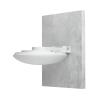-
€
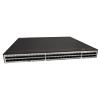
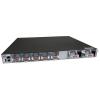
El Huawei S6750-H48Y8C es un switch de clase Enterprise de la familia CouldEngine. Cuenta con 48 ranuras SFP28 (25 Gbps) y 8 ranuras QSFP28 (100 Gbps) y ofrece la máxima capacidad de gestión de su generación. Está diseñado para funcionar como switch principal (núcleo) o de agregación. Se diferencia de los switches de la serie S6730 en que admite routing de segmentos (SRv6 BE) y BGP EVPN, así como la implementación de MACsec. También es compatible con todas las funciones del S6730, como BGP, BGP4+ y MPLS, y ofrece funciones de seguridad avanzadas. Puede funcionar como controlador de acceso inalámbrico (WAC) y controlador de punto de acceso, lo que reduce el número de dispositivos utilizados en la red. El dispositivo está diseñado para aplicaciones de ISP, como switch de agregación en grandes redes de campus o como switch principal (núcleo) en redes de campus pequeñas y medianas. Gracias a su gran capacidad de gestión y a su gran ancho de banda, el S6750-H48Y8C también se puede utilizar con éxito en otras situaciones y ubicaciones.
El dispositivo se aloja en una carcasa para montaje en Rack 19" y el kit incluye todos los accesorios de montaje necesarios. La refrigeración activa se implementa mediante cinco módulos de ventilación con flujo de front-to-back: el aire se aspira desde los puertos y se expulsa por la parte trasera. El kit incluye dos módulos de fuente de alimentación PDC1K2S12 que pueden funcionar de forma redundante; si uno falla, el otro asume el control. El rango de tensión de entrada es de -48 ~ -60 V DC, el consumo máximo de energía del switch es de 200 W y el consumo típico con una carga del 30 % es de 166 W.
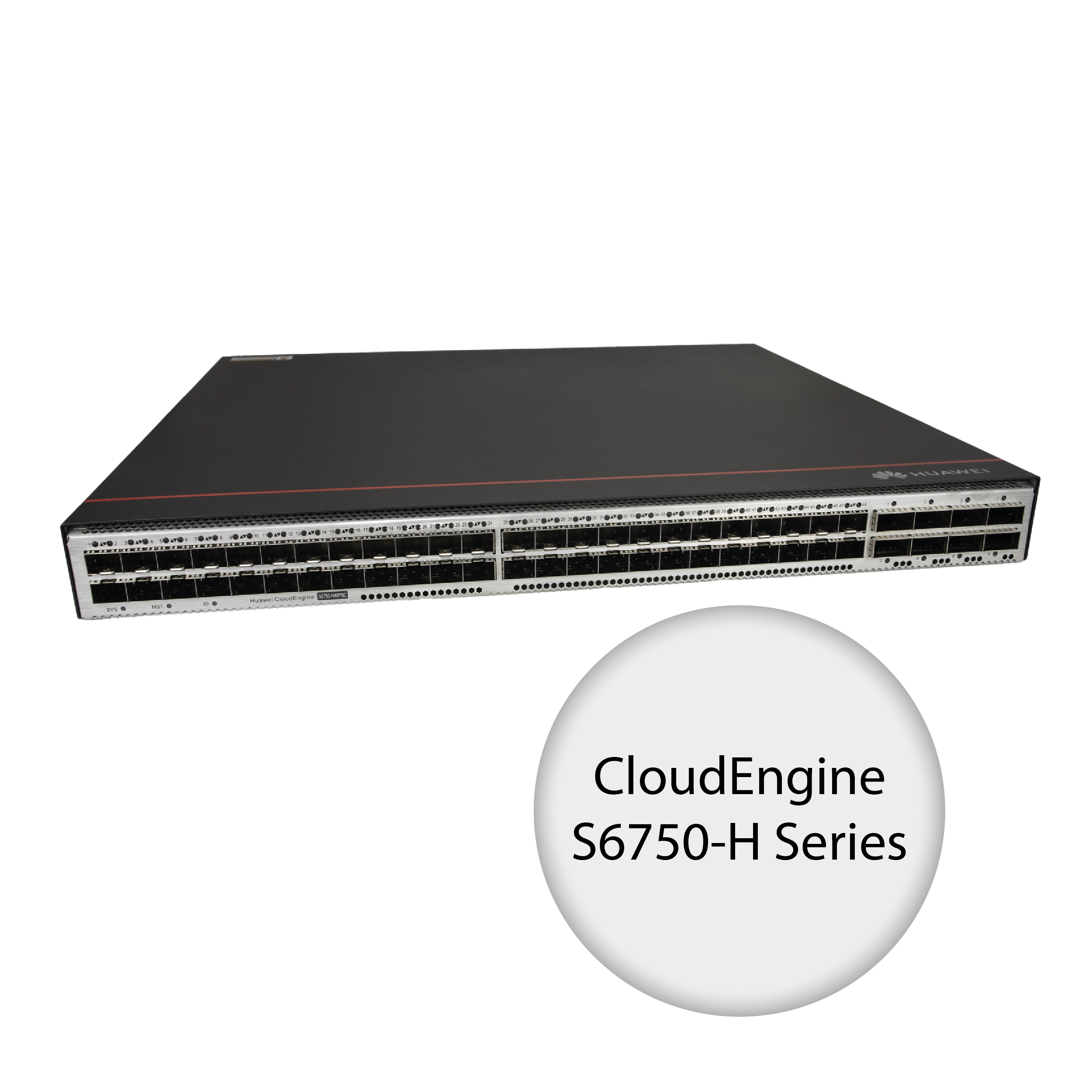
CloudEngine serie S6750-H
El producto ofrecido es un switch de la serie CloudEngine S6750-H. Ofrece las mismas características que el S6730, admite routing, incluyendo BGP y BGP4+, y permite la monitorización de la calidad de la red y la detección de errores en tiempo real. Utiliza IFIT (In-situ Flow Information Telemetry), una tecnología que utiliza paquetes especiales para medir el rendimiento real de la red IP, incluyendo la pérdida de paquetes y la latencia. Hay tres modos IFIT disponibles: application-level, tunnel-level, native-IP, cada uno midiendo una capa de red diferente. El switch admite VRRP (Virtual Router Redundancy Protocol), lo que permite implementar una conexión de enlace ascendente de respaldo. El S6750-H se puede conectar a varios switches mediante múltiples conexiones. El dispositivo también admite funciones más avanzadas que el S6730-H, incluyendo routing de segmentos (SRv6 BE, BGP EVPN) y MACsec.
El dispositivo es compatible con iStack, un stacking inteligente que permite combinar varios switches en un solo dispositivo (desde una perspectiva de gestión). Puede acceder al panel de gestión a través de la nube o mediante otros métodos (consulte la lista en las especificaciones). El switch cuenta con numerosas funciones de seguridad, incluyendo protección contra los ataques más comunes.
Soporte WAC
El S6750-H puede funcionar como controlador de acceso inalámbrico (WAC). Permite la gestión de hasta 1000 puntos de acceso, admite la tunelización cifrada CAPWAP y ofrece muchas otras funciones útiles, cuya lista se puede consultar en las especificaciones. Una ventaja clave para redes grandes es su compatibilidad avanzada con QoS, que incluye la clasificación del tráfico según encabezados L2, protocolos L3 y L4, y prioridad 802.1p.
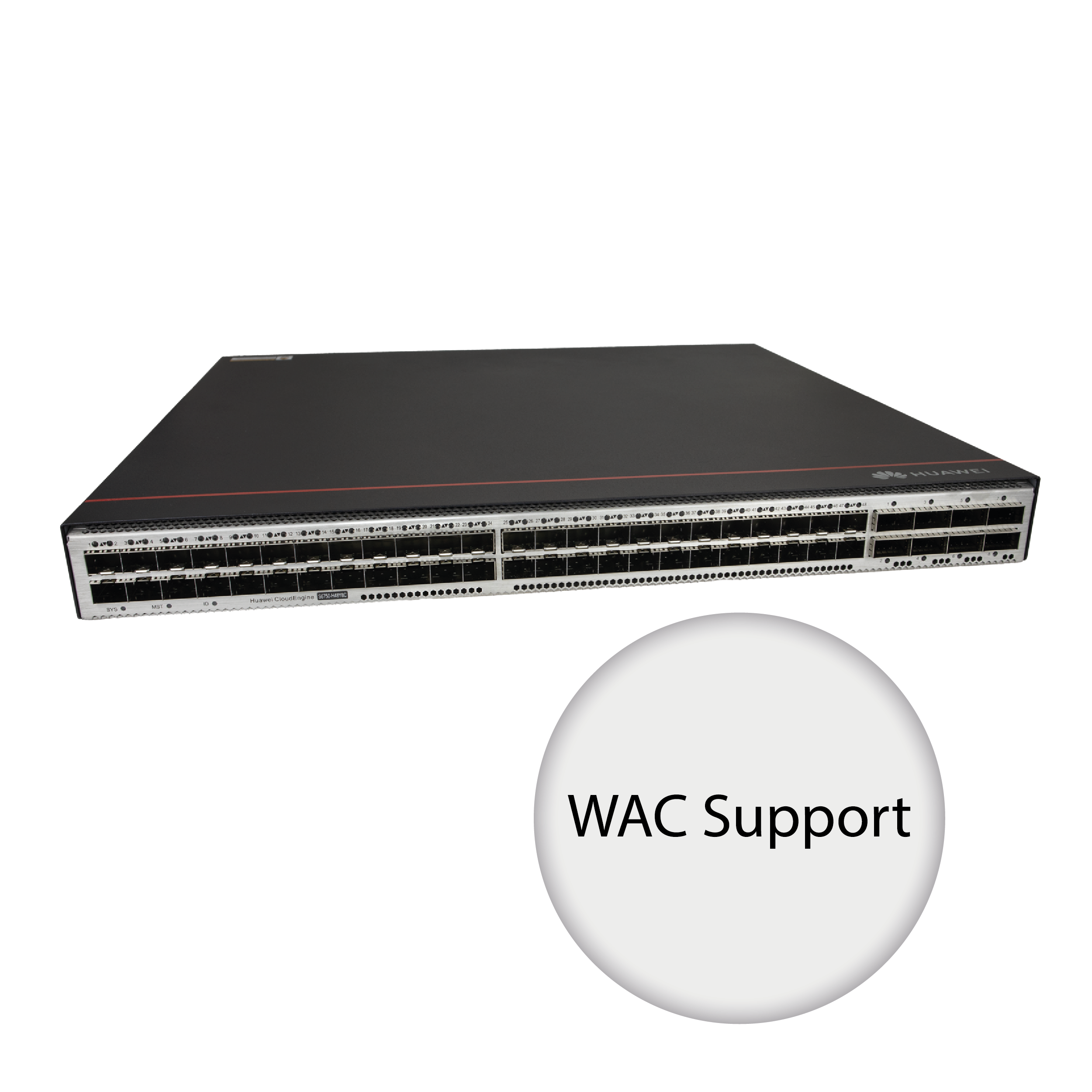
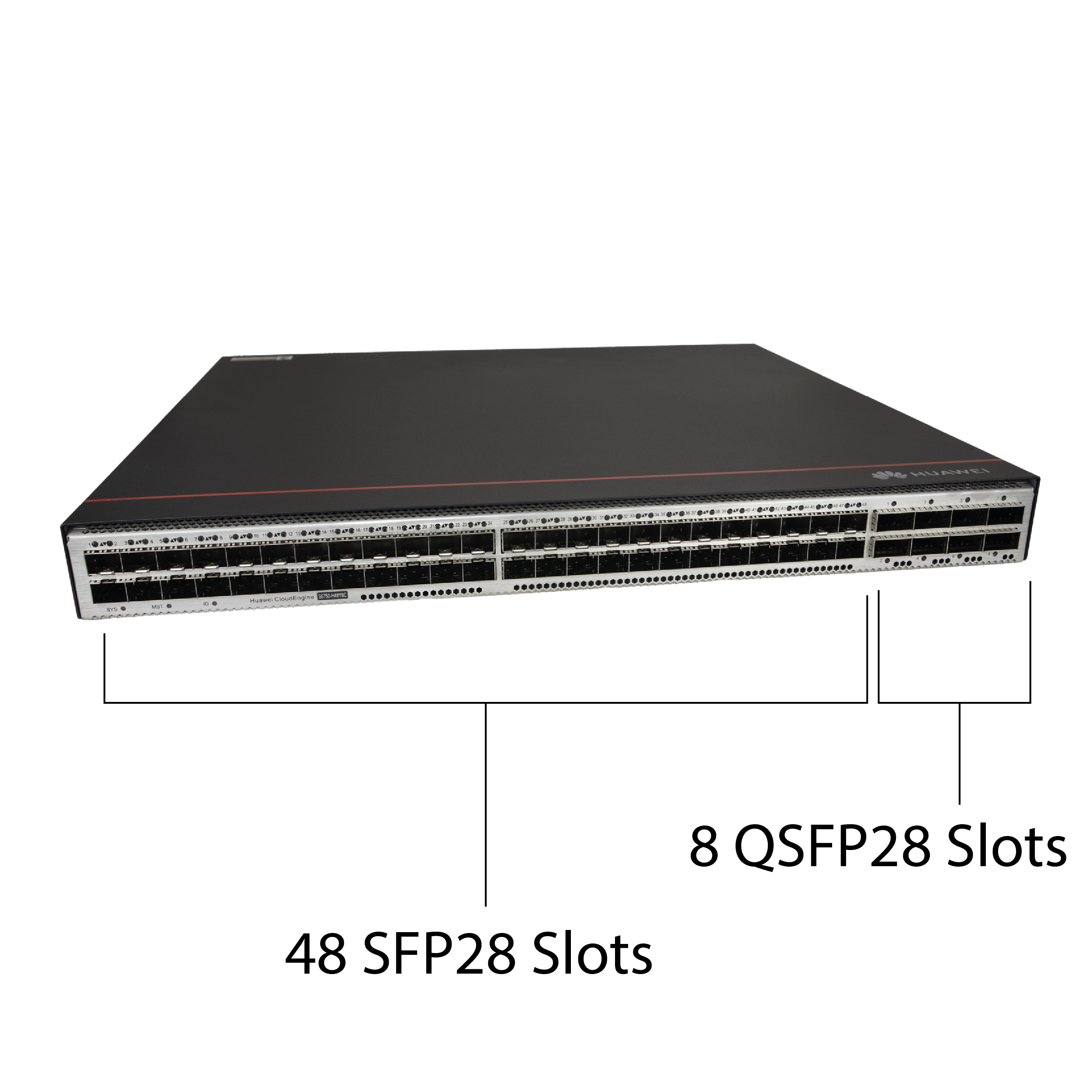
48 ranuras SFP28, 8 ranuras QSFP28
El switch cuenta con 48 ranuras SFP28 con un rendimiento máximo de 25 Gbps y 8 ranuras QSFP28 con un rendimiento de 100 Gbps. Las ranuras SFP28 también pueden operar en modos 1G o 10G, mientras que las ranuras QSFP28 también admiten 40G. La capacidad total de conmutación es de hasta 4 Tbps, y el sistema completo alcanza los 8 Tbps. El dispositivo puede gestionar un tráfico muy alto y garantizar un funcionamiento fluido. Esto lo hace ideal para redes de gran tamaño donde otras soluciones resultan ineficaces. Además, permite construir una infraestructura de red con un rendimiento de 25 Gbps.
Dos fuentes de alimentación DC
El kit incluye dos módulos de fuente de alimentación PDC1K2S12, diseñados para funcionamiento redundante (1+1 power backup). En caso de fallo de la fuente de alimentación, el otro módulo asume el control. El rango de voltaje de entrada es de -48 V ~ -60 V DC; el consumo máximo del switch a plena carga es de 200 W, mientras que el consumo a carga típica (30 %) es de 166 W.
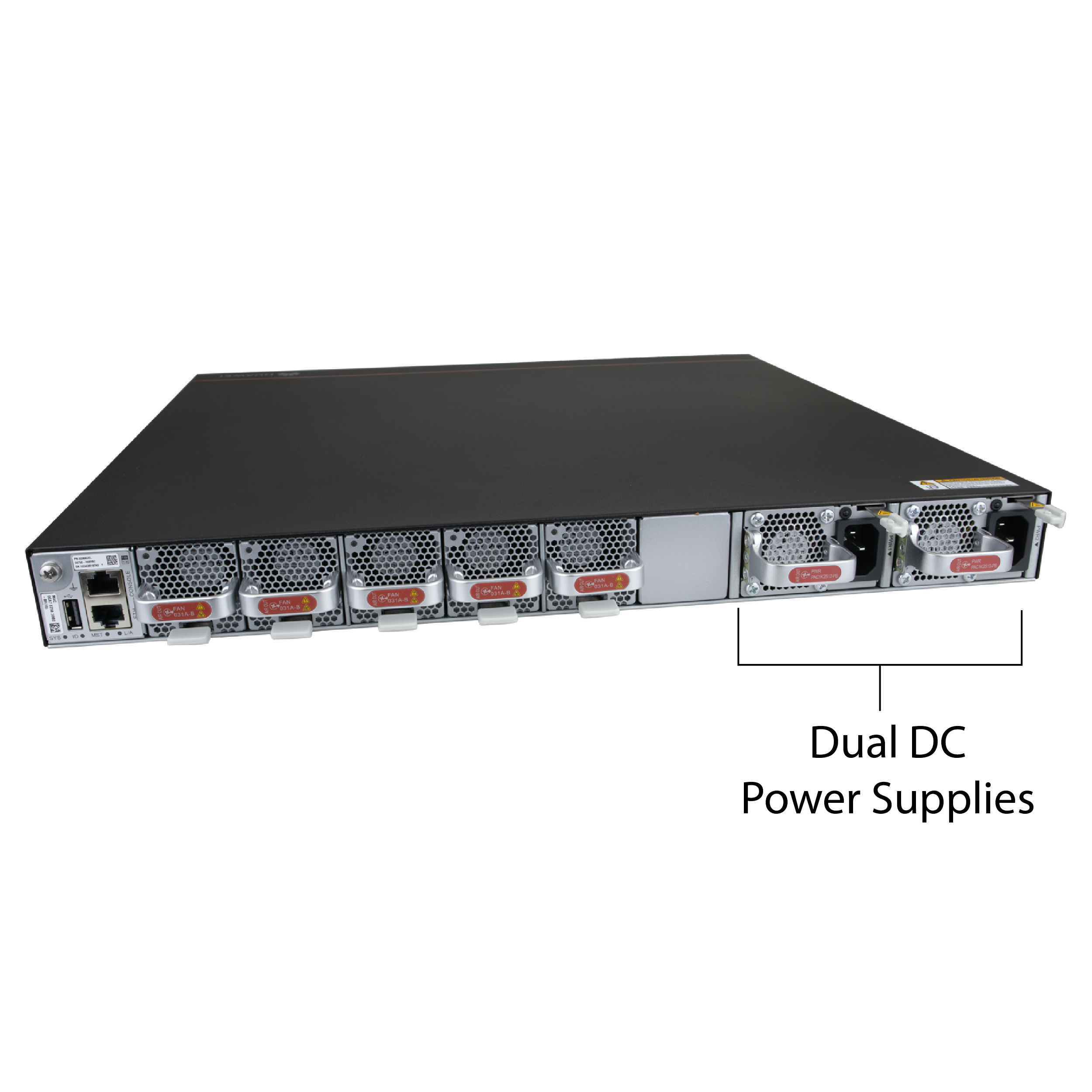
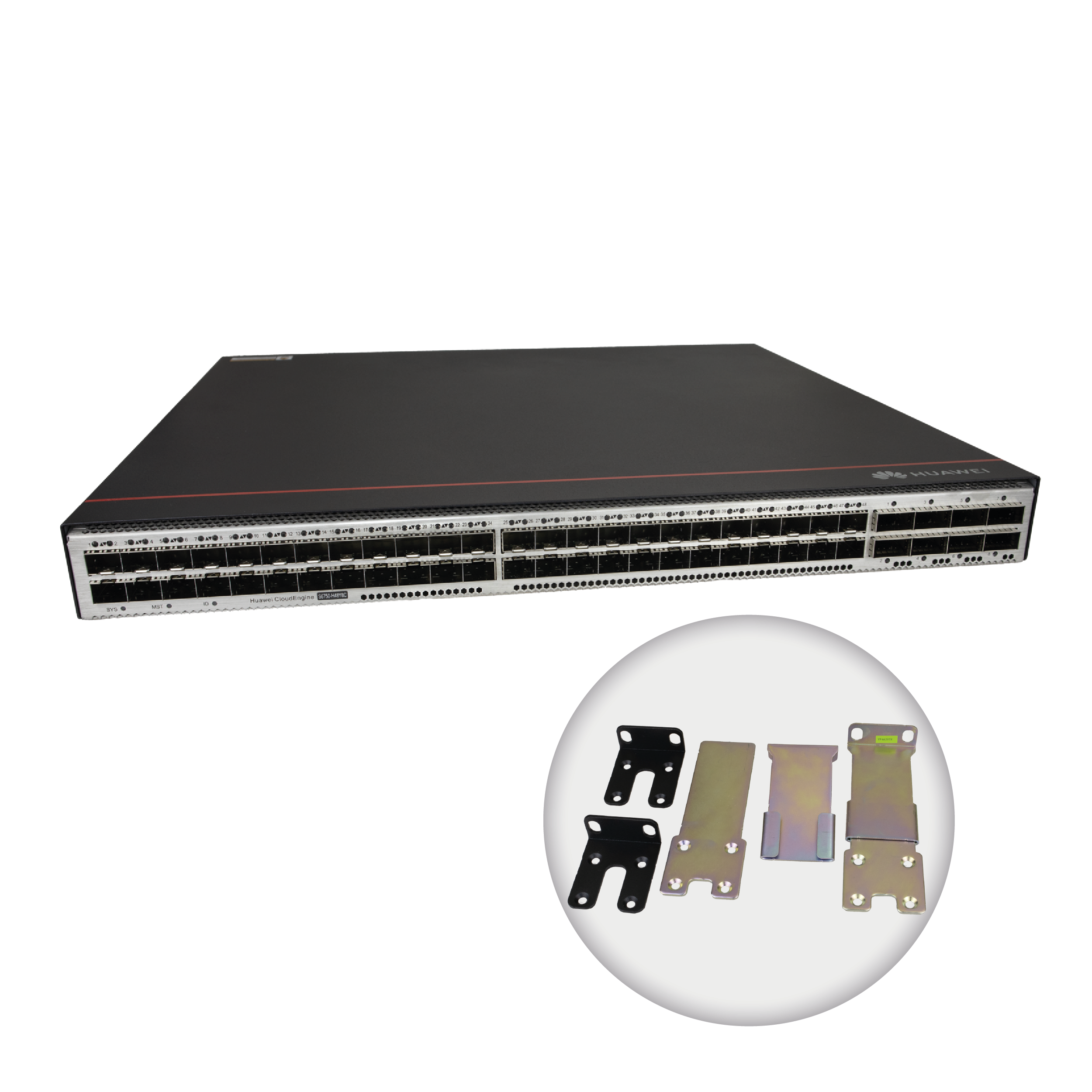
Refrigeración activa, caja para Rack 19"
La carcasa del switch está diseñada para su montaje en un rack 19" y 1 U de altura. El kit incluye los accesorios de montaje necesarios. El dispositivo cuenta con cinco módulos de ventilación intercambiables en caliente que proporcionan refrigeración activa durante su funcionamiento. Cada módulo se puede sustituir rápidamente sin necesidad de apagar el dispositivo ni desmontar toda la carcasa. Los ventiladores, que permiten un flujo de aire de adelante hacia atrás, aspiran el aire de los puertos y lo expulsan por la parte trasera del switch.
Uso
El switch admite gestión avanzada y ofrece un alto rendimiento y capacidad de procesamiento, lo que lo hace ideal para aplicaciones exigentes y redes de gran tamaño. Se puede utilizar con éxito en redes de proveedores de servicios de internet (ISP), especialmente en redes MAN (Metropolitan Area Network). El dispositivo puede utilizarse como switch de agregación en grandes redes de campus o como switch principal (núcleo) en redes de campus pequeñas y medianas. Las aplicaciones del S6750-H son mucho más amplias que las previstas por el fabricante. Gracias a su alto rendimiento, el switch es compatible con una amplia gama de redes, satisfaciendo las necesidades de numerosos administradores y usuarios.
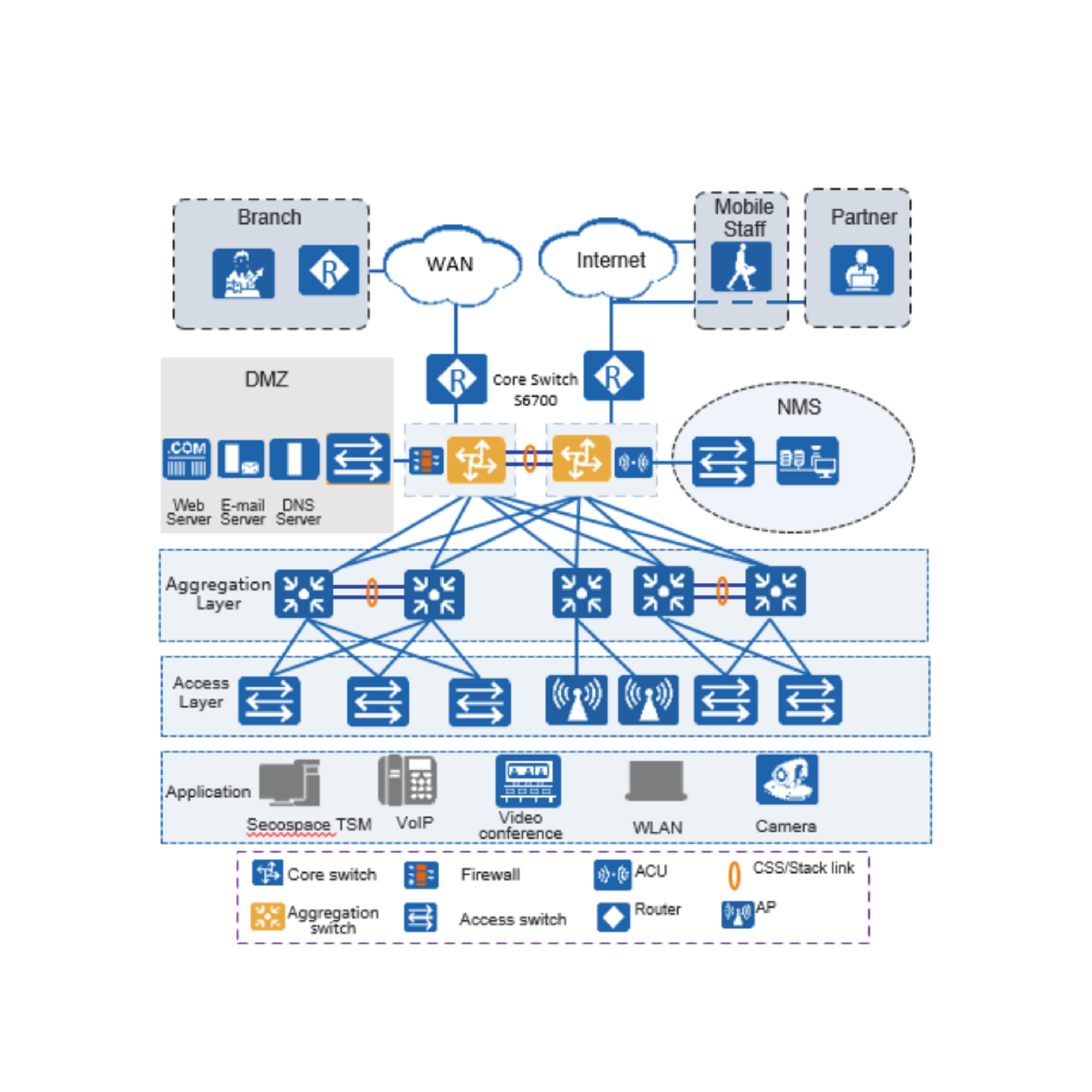
Especificación
| Huawei S6750-H48Y8C | |
| Propiedades de hardware | |
|---|---|
| Dimensiones de la carcasa | 43.6 mm x 442.0 mm x 420.0 mm (1.72 in. x 17.4 in. x 16.54 in.) |
| Altura de la carcasa | 1U |
| Peso (en configuración completa) | 11.23 kg |
| Puertos |
48 ranuras SFP28 (1 / 10 / 25 Gb/s) 8 ranuras QSFP28 (40 / 100 Gb/s) |
| Puertos para gestionar |
Puerto de administración ETH Puerto de consola RJ45 Puerto USB 2.0 |
| Procesador |
Velocidad de reloj: 1,4 GHz Número de núcleos: 4 |
| Memoria |
8 GB mamoria RAM 4 GB memoria Flash |
| Tipo de energía | 2 fuentes de alimentación 1200 W DC |
| Rango de voltaje sugerido | -48 V ~ - 60V DC |
| Rango de voltaje máximo | -38,4 ~ -72 V DC |
| Corriente de entrada máxima | 38 A |
| Consumo de energía típico con una carga del 30 % | 166 W |
| Consumo máximo de energía (100 % de rendimiento, velocidad máxima del ventilador) | 200 W |
| Método de enfriamiento | Refrigeración activa por aire forzado, ajuste inteligente de la velocidad del ventilador |
| Número de módulos de ventilador | 5 |
| Circulación de aire | Front-to-back, el aire se toma desde el lado de babor y se expulsa desde la parte trasera |
| Temperatura de funcionamiento admisible |
0 - 1800 m n.p.m.: -5°C ~ 45°C 1800 - 5000 m sobre el nivel del mar: el rango de temperatura disminuye 1° por cada 220 m |
| Temperatura de almacenamiento admisible | -40°C ~ 70°C |
| Humedad del aire admisible | 5% - 95% sin condensación |
| Altura máxima de trabajo | 0 - 5000 m |
| Nivel de potencia acústica en condiciones estándar | 58.4 dB(A) |
| Nivel de potencia acústica a temperatura elevada | 82.1 dB(A) |
| Nivel de presión sonora en condiciones estándar | 57.2 dB(A) |
| Protección contra sobretensiones de la fuente de alimentación | ±6 kV modo diferencial, ±6 kV modo común |
| MTBF (años) | 29.72 |
| MTTR (horas) | 2 |
| Disponibilidad | > 0.99999 |
| Propiedades del software | |
| Gestión de usuarios |
Gestión de usuarios unificada Autenticación 802.1X Autenticación MAC Registro de datos de tráfico y duración de la sesión Autenticación de usuarios basada en grupos de usuarios, dominios y rangos de tiempo Marcos Jumbo: 9500 B |
| MAC |
Guardado y eliminación automáticos de direcciones MAC Máximo 512K entradas MAC Entradas de dirección MAC: estáticas, dinámicas, blackhole Filtrado de origen de direcciones MAC Límite de aprendizaje de direcciones MAC según el puerto y la VLAN |
| VLAN |
4K VLANs Modos access, trunk, hybrid Default VLAN QinQ y enhanced selective QinQ Stacking y mapeo de VLAN Asignación dinámica de VLAN a dirección MAC |
| ARP | ARP Snooping |
| DHCP |
DHCPv4 cliente / relay / servidor, DHCPv4 Snooping DHCPv6 cliente / relay / servidor, DHCPv6 Snooping |
| Routing IP |
Protocolos de routing IPv4 dinámico como RIP, OSPF, IS-IS y BGP Protocolos de routing IPv6 dinámico como RIPng, OSPFv3, ISISv6 y BGP4+ Routing Policy, Policy-Based Routing VRF |
| Segment Routing |
SRv6 BE (L3 EVPN) BGP EVPN Konfiguracja SRv6 por NETCONF |
| Multicasts |
IGMP v1/v2/v3 e IGMP v1/v2/v3 Snooping PIM-DM, PIM-SM, PIM-SSM, PIMv6 Mecanismo fast-leave Control de tráfico multicast Multicast querier Multicast protocol packet suppression |
| MPLS |
MPLS-LDP MPLS-L3VPN MPLS QoS |
| QoS |
Clasificación de tráfico basada en encabezados Layer 2, protocolos Layer 3, protocolos Layer 4 y prioridad 802.1p Listas de acceso ACL, CAR (Committed Access Rate), re-marking, horario Algoritmos de cola como PQ, DRR, WDRR, PQ+DRR, PQ+WDRR WRED, tail drop Conformación del tráfico Hasta 8 colas por interfaz Network Slicing |
| Native-IP IFIT |
Marca paquetes para proporcionar información en tiempo real sobre la pérdida de paquetes y su tasa de pérdida. El periodo de las estadísticas se puede modificar. Medición bidireccional del retardo de trama. |
| Protección de bucle Ethernet |
STP (IEEE 802.1d), RSTP (IEEE 802.1w), and MSTP (IEEE 802.1s). Protección BPDU, Protección root (root protection), detección de bucles G.8032 ERPS (Ethernet Ring Protection Switching) SEP (Smart Ethernet Protection) |
| Fiabilidad |
M-LAG (tiempo de conmutación < 2 s) Stacking de servicios basado en interfaz Número máximo de dispositivos en una pila Rendimiento de la pila (bidireccional) LACP (Link Aggregation Control Protocol) y E-Trunk VRRP (Virtual Router Redundancy Protocol) y BFD (Bidirectional Forwarding Detection) y VRRP BFD do BGP / IS-IS / OSPF / statycznych tras Eth-OAM 802.1ag (CFM) Smartlink LLDP Y.1731 |
| Gestión del sistema |
iStack, número máximo: 9 Terminal de consola Terminal Telnet / IPv6 Telnet SSH v1.5 SSH v2.0 SNMP v1/v2c/v3 FTP, TFTP, SFTP Actualización de BootROM y actualización remota sobre la marcha Hot patch Etiquetas del usuario OPS (Open Programmability System) Streaming Telemetry GVRP iPCA, NetStream, NQA, Telemetry 1588v2 |
| Seguridad y gestión |
NAC Puerto security Autenticación de inicio de sesión RADIUS y HWTACACS MACsec La línea de comandos tiene una función de seguridad que verifica si el nivel de permiso del usuario permite la ejecución de un comando determinado. Protección de ataques DoS, TCP (Transmission Control Protocol) SYN Flood, UDP (User Datagram Protocol) Flood, broadcast storm y protección contra ataques de movimiento intenso IPv6 RA Guard Colas de CPU de hardware para implementar la programación jerárquica y la protección de paquetes de la capa de control RMON (Remote Network Monitoring) Secure boot Port mirroring ND snooping |
| Controlador WLAN: servicios y funciones básicas |
Copia de seguridad de dispositivos con funcionalidad WLAN AC incorporada en modo clúster Balanceo de carga de 2,4 y 5 GHz Prioridad 5 GHz |
| Controlador WLAN - Gestión de puntos de acceso |
Número total de puntos de acceso administrados: 1K Red IPv4 entre el punto de acceso y el controlador WLAN AC Lista negra AP Lista blanca AP Configuración del modo de control de acceso AP Configuración y gestión de AP AP LLDP topology awareness |
| Controlador WLAN - Gestión de usuarios inalámbricos |
Roaming de usuarios dentro del AC WLAN Ubicación del usuario según el punto de acceso Autenticación 802.1X Autenticación de dirección MAC Portal de autenticación |
| Controlador WLAN - CAPWAP |
Reenvío directo en redes L2/L3 Reenvío de datos basado en túneles en redes L2/L3 Cifrado de túnel CAPWAP |
| Controlador WLAN - Gestión de radio |
802.11a/b/g/n 802.11ac wave1/wave2 802.11ax Monitoreo y prevención de interferencias de radio Detección de interferencias en el canal, interferencias de canales adyacentes e interferencias de otros dispositivos Selección automática de canales y potencia de radio cuando el AP se conecta Optimización dinámica de canales y potencia |
| Controlador WLAN - Calidad de servicio WLAN |
Límite de tráfico upstream y downstream basado en VAP Límite de tráfico upstream y downstream basado en usuarios CAR para usuarios de WLAN |






 Polski
Polski English
English Italiano
Italiano Español
Español Čeština
Čeština Српски
Српски Deutsch
Deutsch Ελληνικά
Ελληνικά Slovenský
Slovenský

